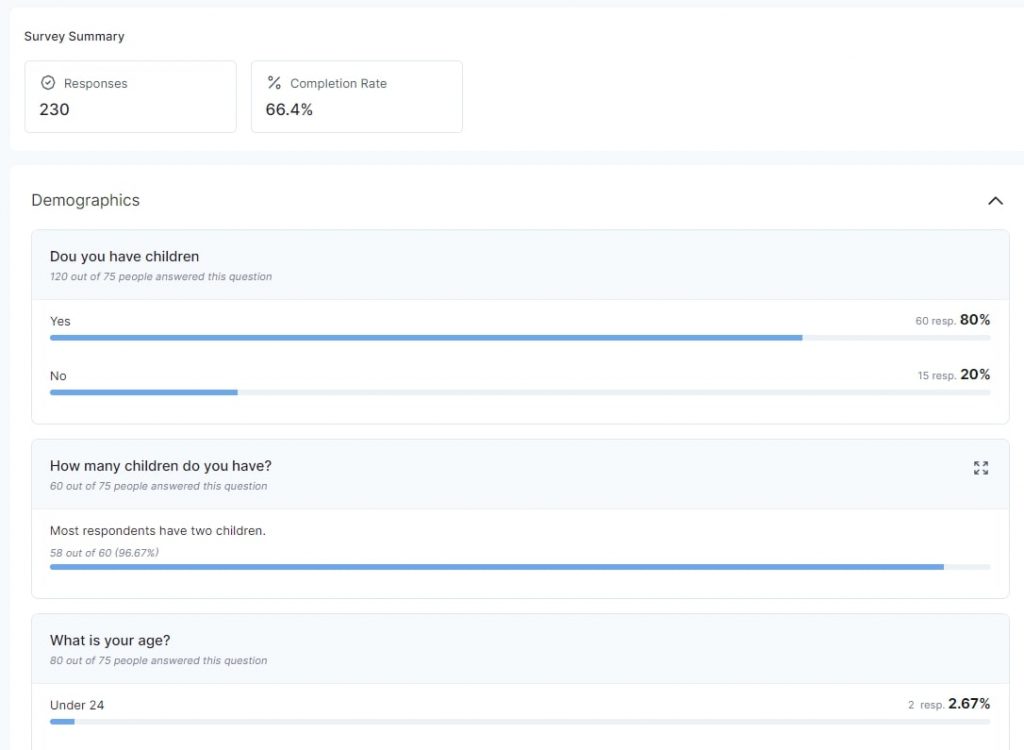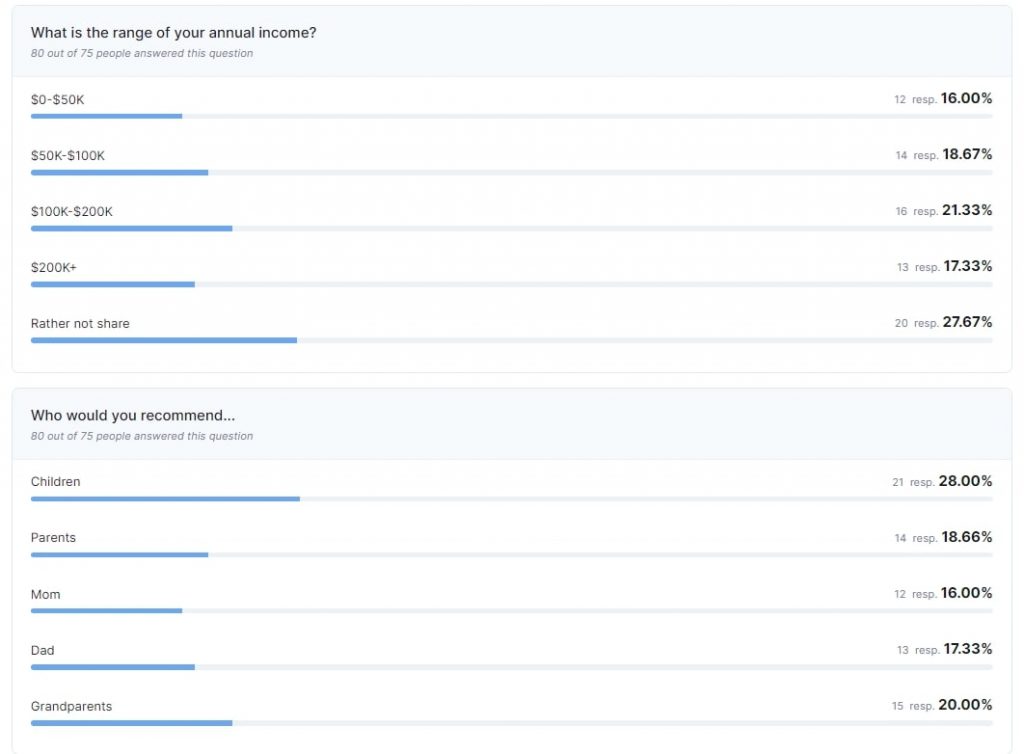In the modern business landscape, launching a new product or entering a market without research is akin to stepping onto a battlefield without intel.
Market research arms you with the data-driven strategies you need to compete effectively, minimize risks, and maximize your chances of success. It fosters a deep understanding of market dynamics and consumer behavior, giving you the edge you need to thrive in a challenging and complex marketplace.
But with the myriad of market research techniques available and the rapidly evolving tech industry, how do you conduct market research that isn’t just good — but great?
This guide explores the next-gen approach to market research, leveraging innovative strategies and cutting-edge tools designed to make your foray into product development and market entry more informed, efficient, and ultimately, profitable.
#1 Define Your Target Audience
The guiding star of any successful product launch or market entry is a well-defined target audience. This segment of the population represents who you aim to serve with your product, and understanding them is pivotal. But mere intuition won’t do. Here’s how to pinpoint your customer base accurately.
Understand Psychographics as Well as Demographics
It’s not enough to know the age, gender, and income bracket of your potential consumers. You need insights into their lifestyles, values, challenges, and aspirations.
When you launch a trial campaign with the Prelaunch idea validation platform you immediately begin gathering data on both the demographic and psychographic front. The goal is to connect your brand with its future customers and give deeper insights into their needs.
(A dedicated section that contains data-based customer profiles is also available that ensures you speak to them effectively in your future marketing and product development.)


Map Out Their Customer Journey
Every touchpoint with your brand is an opportunity to delight or disappoint your prospective customers. By mapping out their customer journey, you gain insights into how they become aware of your product, how they research their options, and how they make a purchase. This is invaluable for optimizing your marketing and sales funnel.
Here’s a breakdown of how to create a customer journey map:
1. Define your goals and target audience:
- What do you want to achieve with the customer journey map? Is it to understand pain points, improve specific touchpoints, or gain insights into the overall customer experience?
- Who is your target persona? Clearly define the specific customer segment you’re focusing on.
2. Gather customer data:
- Conduct surveys, user interviews, and focus groups to understand customer thoughts, feelings, and experiences when interacting with your brand. (See sections #8 and #9)
- Analyze website analytics and customer service interactions to identify common touchpoints and pain points. (See section #10)
3. Identify customer touchpoints:
- List all the interactions a customer has with your brand throughout their journey, from initial awareness to post-purchase interactions. This includes online interactions (website, social media), offline interactions (stores, events), and customer service touchpoints.
4. Map the customer journey:
- Visualize the customer journey chronologically, with touchpoints listed across a timeline.
- You can use a whiteboard, a spreadsheet, or dedicated customer journey map templates available online.
5. Define customer actions and emotions:
- For each touchpoint, describe the actions the customer takes and their emotional state. Are they frustrated, confused, or excited?
6. Analyze pain points and opportunities:
- Identify areas where the customer experience is weak and opportunities for improvement.
- Look for inconsistencies, frustrations, or roadblocks in the journey.
7. Develop solutions and improvements:
- Brainstorm solutions to address the identified pain points.
- This could involve changes to marketing messages, website design, customer service processes, or product features.
8. Prioritize improvements:
- Not all improvements will have the same impact. Prioritize based on feasibility and potential impact on the customer experience.
9. Create an action plan:
- Develop a concrete plan to implement your identified improvements.
- Assign ownership, deadlines, and track progress.
10. Monitor and iterate:
- Your customer journey map is a living document.
- As you implement changes and gather new data, update your map and continue to iterate on your customer experience.
#2 Size up the Competition
The competition is more than just competition. Competitors are collaborators who are developing the same industry you are. So, knowing what they’re up to is key. Competitor analysis helps you understand the strengths and weaknesses of other products and businesses in your market. That’s why it remains a key point in the goal-setting process on Prelaunch.
Identify Direct and Indirect Competitors
Direct competitors offer similar products or services to the same customer group. But don’t forget about the indirect competitors; these are businesses whose products may not be the same but serve the same need or solve the same problem.
For instance, direct competitors of KitchenAid offer kitchen appliances similar to those of the same customer group. Indirect competitors are businesses that may not provide the same products but serve the same needs for cooking or kitchen solutions.

KitchenAid’s direct competitors include brands like Cuisinart, Breville, and Hamilton Beach, offering similar kitchen appliances targeting the same consumer base.
On the other hand, KitchenAid’s indirect competitors comprise a broader spectrum of kitchenware and culinary solutions that cater to the same cooking needs, such as traditional cookware brands, cooking blogs, cooking classes, and kitchen gadget companies. Despite offering different products, they all fulfill the common requirement for cooking and kitchen-related solutions.
Analyze Their Strengths and Weaknesses
Conduct a SWOT analysis (Strengths, Weaknesses, Opportunities, and Threats) for each competitor. Look for areas where they excel and where they fall short. This could be anything from pricing and quality to branding and customer service.
SWOT Analysis of Cuisinart
Strengths:
- Brand Recognition: Cuisinart has a strong brand presence and is well-regarded in the kitchen appliance industry, which aids in consumer trust and loyalty.
- Product Variety: They offer a wide range of kitchen appliances, from food processors to coffee makers, catering to broad consumer needs and preferences.
- Innovative Design: Cuisinart is known for innovative products that incorporate the latest technology and ergonomic designs, enhancing user experience.
- Quality and Durability: Their products are durable and of high quality, which ensures long-term customer satisfaction and reduces the need for frequent replacements.
Weaknesses:
- Price Point: Cuisinart’s products are generally priced higher than some of its competitors, which can be a barrier for budget-conscious consumers.
- Market Saturation: With the vast array of products offered, some consumers may feel overwhelmed by choices, leading to decision fatigue.
- Heavy Dependence on Retail Partners: A significant portion of sales comes through third-party retailers, which poses a risk if these relationships are not maintained.
Opportunities:
- Eco-friendly Initiatives: There is a growing market for eco-friendly and sustainable kitchen appliances. Cuisinart could expand or highlight their offerings in this area.
- Direct-to-Consumer Sales: By enhancing their online presence and e-commerce capabilities, Cuisinart can build direct relationships with consumers, improving customer insights and loyalty.
- Expansion into Emerging Markets: Targeting emerging markets with growing middle classes could represent a significant growth opportunity for Cuisinart.
Threats:
- Intense Competition: The kitchen appliance market is highly competitive, with many players offering similar products, leading to a constant battle for market share.
- Technological Advancements: Rapid technological changes require continuous research and development to stay ahead, which can be costly.
- Economic Downturns: In economic downturns, consumers are less likely to spend on premium kitchen appliances, potentially affecting sales.
#3 Look at Market Size and Trends
How big is your market, and how fast is it growing? These questions are central to understanding the opportunities available to you and the potential demand for your product.
Utilize Market Research Reports
Industry analysts often release market research reports that can provide you with a snapshot of the current market size and growth trends. These reports can be expensive, but they are often very comprehensive and reliable.
Consider these reliable sources in your next market research efforts:
- Gartner: A world-leading research and advisory company that provides reports on information technology, operational technology, and digital marketing.(Gartner offers a subscription-based model where businesses can access various reports and gain insights into different industry trends.)
- Forrester: Forrester focuses on helping businesses understand their customers and develop winning customer strategies. Their reports provide insights into customer behavior, trends, and best practices.
- IDC: IDC provides reports on information technology, telecommunications, and consumer technology markets. Their reports offer valuable insights into industry trends, market sizing, and vendor analysis.
Tap Into Government Data
Sometimes the best source of market data is the government, which may collect statistics on industries or consumer groups. This can be an effective and economical way to gather market sizing data.
Here are some helpful government sources (especially good for looking at US markets):
- National Center for Science and Engineering Statistics (NCSES)
- Data.gov
- U.S. Bureau of Labor Statistics (BLS)
#4 Create Landing Pages with Lead Magnets
A strong online presence is critical to a successful product launch. Building a landing page on Prelaunch with lead magnets is a great way to capture the attention of potential customers and gather invaluable data.
Offer Valuable Resources
In exchange for their email address, provide leads with something of value. This could be an e-book, a webinar, or a discount code. With Prelaunch’s proprietary subscription/reservation model, leads leave their email address and are then invited to reserve the product at a discount. The key here is to offer something that aligns with their needs and interests.
Use A/B Testing to Optimize
A/B testing is a method of comparing two versions of a web page to see which one performs better. This form of testing on Prelaunch involves testing different copy and images, as well as different positioning to see which angles can best be used to promote your product. Use the data gathered from testing to optimize your landing pages for conversions.
For example, if you are testing the launch of a new coffee maker and the data you collect indicates that potential buyers are particularly interested in the fact that it is self-cleaning you would know to emphasize that benefit in marketing materials.
#5 Launch Pre-order Campaigns (aka Prelaunch campaigns)
Launching a pre-order campaign can help you generate buzz and secure early sales. It’s also a powerful form of market research, giving you insight into demand well before you actually have a product to sell. Creating a landing page on Prelaunch helps you do just that.
Set Realistic Expectations
Don’t expect to sell out your entire inventory before you’ve even manufactured the product. Pre-orders should be seen as a way to gauge interest and generate excitement rather than as a significant revenue stream.
Communicate Clearly with Customers
Be transparent about the pre-order process, including estimated delivery dates and potential risks. This is a good practice to implement across the board, but especially useful for those creators hailing from the crowdfunding world. This process builds trust with your customers and manages their expectations appropriately.
Use Pre-order Data to Inform Production
The information you gather from pre-orders is invaluable in planning your initial production run. This is why Prelaunch features a position and version testing tool. Based on the results, you’ll be able to determine what features of your product are most in demand, and what product benefits to capitalize on in your marketing efforts.
#6 Conduct Price Testing
How much are customers willing to pay for your product? Will your price point be seen as a bargain, or is there room to increase your margin?
Calculate Your Costs and Desired Margin
Your pricing strategy should be informed by your costs and desired profit margin. Take into account the cost of goods sold, marketing and sales expenses, and any other operational costs associated with bringing your product to market.
Here’s a formula you can use here is a formula you can use to calculate your desired profit margin on a physical product. Here’s how it works:
1. Identify your desired profit margin percentage: This is the percentage of profit you want to make on each product sale. Consider factors like industry standards, production costs, and competitor pricing.
2. Find your total cost per unit: This includes all the costs associated with making and selling your product. This includes:
- Cost of materials: Raw materials, components, packaging, etc.
- Manufacturing costs: Labor, assembly, machinery usage, etc.
- Overhead costs: Rent, utilities, salaries (not directly tied to production), etc.
3. Use this formula to calculate your selling price:
Selling price = Total cost per unit / (1 – Desired profit margin %)
For example:
- Let’s say you want a 20% profit margin.
- Your total cost per unit is $10.
- Plug these values into the formula:
Selling price = $10 / (1 – 0.20)
Selling price = $10 / 0.80
Selling price = $12.50
In this example, you would need to sell your product for $12.50 to achieve a 20% profit margin.
Remember: This is a simplified formula and may need adjustments based on your specific business situation. You may also want to consider additional factors like shipping costs, discounts, and marketing expenses.
Validate Product Price
Prelaunch’s pricing validation tool lets creators experiment with multiple pricing options for a single product, aiming to identify the most effective pricing strategy. While many companies rely on competitor analysis, production costs, and guesswork for pricing decisions, Prelaunch breaks the mold. We simplify price testing and reduce inaccuracies by leveraging real-time data and behavioral cues. Balancing customer willingness to pay with profitability is crucial. Ensure your pricing strategy aligns perfectly with market expectations.
#7 Identify Distribution Channels
How will your product reach the hands of your customers? The right distribution strategy can be a significant competitive advantage.
Here’s what you need to keep in mind when crafting your strategy:
1. Consider Your Product:
- Complexity and size: Bulky or fragile items might require specialized handling that some channels can’t provide.
- Perishability: Perishable goods need temperature-controlled storage and fast delivery, limiting channel options.
2. Analyze the Channel:
- Reach and target audience: Does the channel reach your ideal customers? Does it offer broad market access or cater to a niche?
- Cost structure: Evaluate fees, commissions, storage costs, and marketing expenses associated with the channel.
- Level of control: How much control do you have over pricing, product placement, and brand messaging within the channel?
- Customer service: Who handles customer service for the product? Does it align with your brand image and customer expectations?
3. Weigh the Pros and Cons:
- Direct Sales (Your own online store):
- Pros: High control over brand and pricing, collect customer data.
- Cons: Requires marketing efforts to drive traffic, managing logistics and customer service can be demanding.
- Retail Stores:
- Pros: Established customer base, impulse purchases, physical presence.
- Cons: Less control over brand and pricing, potential for shelf competition, margins can be lower due to markups.
- Online Marketplaces:
- Pros: Wide reach, convenience for customers, established infrastructure.
- Cons: High competition, potential for price wars, platform fees and regulations.
- Wholesalers and Distributors:
- Pros: Reach a large network of retailers, reduced logistics and customer service burden.
- Cons: Less control over pricing and brand, reliant on distributors’ marketing efforts.
4. Additional Considerations:
- Scalability: Can the channel handle your projected growth?
- Brand fit: Does the channel align with your brand image and target audience perception?
- Competitor analysis: How do your competitors utilize distribution channels?
#8 Gather Feedback via Surveys and Questionnaires
Gathering feedback from potential customers is crucial in refining your product and marketing strategy. Surveys and questionnaires are a cost-effective and scalable method for doing so. (Just remember always to keep it brief.)
Craft Clear and Concise Questions
The design of your survey is just as important as the answers you receive. Use unambiguous questions and keep the survey as short as possible to maximize completion rates.
Utilize Incentives for Participation
If you want people to take time out of their day to answer your questions, offer them an incentive. This could be a sweepstake entry, a small discount, or early access to the product.
Use Online Platforms for Convenience and Scale
Online platforms like SurveyMonkey, Google Forms, or Typeform make it easier to reach a large audience and gather insights quickly. However, it’s worth mentioning that surveys are an embedded part of Prelaunch’s funnel.
For example the Reservation Survey appears on the Thank you page after a potential buyer reserves the product, allowing us to ask questions that can help improve the product and recognize the buyer persona.
The Cancellation Survey appears when an individual clicks the “No, thanks” button on the Reservation page, providing you with feedback on why they chose not to reserve the product and what would make them reconsider.
#9 Consider Conducting Focus Groups
Focus groups provide more in-depth, qualitative feedback on your product or service. They can shed light on how customers perceive your brand and can provide insights that quantitative data alone can’t.
With that being said, at Prelaunch, we understand that focus groups are an expensive tool in the tool belt of market research. This is why if you decide you do want to shell out on a focus group, we make it worth your while. How? By speaking to a group of people who have already reserved the product a ta discount, thereby indicating their willingness to buy.
If you are going through the process of organizing a focus group on your own, keep the following points in mind:
Recruit Diverse Participants
A variety of perspectives can make your focus group more informative. Try to recruit participants from different demographics and backgrounds to ensure a well-rounded discussion.
Use a Skilled Moderator
The success of a focus group often depends on the skill of the moderator. They should be able to encourage open and honest discussion without leading the participants.
Below is an example of what a skilled moderator would ask versus an unskilled one.
Well-Formulated Focus Group Question:
“Thinking about how you use [product category] in your daily life, can you describe a situation where this new product (show the product) might be helpful or convenient? What specific tasks or challenges do you think it could address?”
This question is open-ended and encourages participants to share their honest opinions and experiences. It avoids leading them towards a specific answer and allows them to consider the product’s potential uses from their own perspective.
Poorly Formulated (Leading) Focus Group Question:
“This new product is specifically designed to make [specific task] easier. How much easier do you think this product would make your life compared to the products you currently use?”
This question is leading because it assumes the product will be helpful and asks participants to quantify that benefit. It doesn’t allow them to consider if the product actually solves a problem they have or if it might be cumbersome or unnecessary.
Observe and Record Interactions
In addition to the discussions, observe the body language and other non-verbal cues of the participants. Record the sessions so that you can review them later to catch any details you missed the first time.
#10 Practice Social Listening
The online world is a treasure trove of unfiltered consumer opinions. Social listening allows you to tap into these conversations and use the insights to inform your market research.
Monitor Multiple Channels
Social listening involves monitoring various online platforms to get a comprehensive view of public sentiment. This could include social media, review sites, forums, and blogs.
So for a creator launching an e-bike for example, it’s imperative to monitor specific channels to gauge consumer sentiment and identify trends. These channels can include:
- Social Media Platforms: Instagram and Twitter are particularly useful for spotting trends and customer opinions. Hashtags such as #ebike, #electricbicycle, and #ecofriendlytransport can provide a wealth of user-generated content and feedback.
- Review Sites: Websites like Trustpilot or Consumer Reports can offer insights into similar products’ performance and customer satisfaction levels.
- Cycling Forums and Blogs: Dedicated cycling forums like BikeForums.net or the Electric Bike section of Reddit can provide deep insights from cycling enthusiasts. These platforms often host passionate discussions about the latest e-bike technologies, features, and brands.
- YouTube Channels: Many creators focus on reviewing e-bikes, offering detailed insights into their performance, usability, and value for money. Monitoring the comment sections of these videos can also provide direct feedback from potential customers.
By carefully monitoring these channels, an e-bike creator can gather invaluable feedback, identify potential issues or desires, and better understand their target market.
Use Dedicated Tools for Efficiency
While social listening can be done manually, there are many tools and services that can automate and streamline the process. These can range from simple keyword alerts to sophisticated sentiment analysis.
Prelaunch’s AI Market Research tool is a great example. Simply by entering the kind of product you plan to launch and by inserting the links of a few competitor products on Amazon, you’ll be able to get a summary of users’ comments, ratings, and feedback within minutes.
Respond to Engagement Wisely
If you encounter direct engagement with your brand, respond appropriately. This could involve resolving a customer complaint, answering questions, or engaging with positive feedback to encourage further advocacy.
#11 Conduct Prototype Testing
Before you go to market with your product, it’s essential to test it with real users. This can help you identify any usability issues or areas for improvement before it’s too late.
Create Low-Fidelity Prototypes
Testing can begin with simple mockups or prototypes that give an idea of the product without requiring a significant investment of time or resources. Use mockups like these as the basis for your Prelaunch landing page.
Gather Feedback Early and Often
Once your landing page is live, you’ll begin gathering feedback on the Prelaunch dashboard. This iterative approach will lead to a more polished product by the time you’re ready to launch.
Use the Feedback to Improve
The whole point of prototype testing is to get actionable feedback. Use what you’ve learned to make necessary adjustments and continue testing until you’re confident in the product.
By contrast, there’s an entire wall of flops when creators failed to pre-launch before they launched. Make sure your next brainchild doesn’t end up here.
Wrap-up
In conclusion, the next-gen approach to market research is an interplay of traditional techniques with cutting-edge strategies and tools. By seeking new ways to gather insights, staying flexible in your methods, and always keeping the customer at the forefront, your market research will not only guide your product development but also instill confidence in your business decisions.
Remember, the more informed you are, the more resilient and adaptable your business will be in the face of an ever-changing market. And when it comes to market research, Prelaunch idea validation platform is your partner in success. Book a demo to see how it works today.




